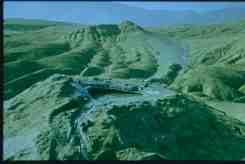 |
Romania, an eastern European country, is severely affected by a variety of natural
hazards. These include frequent earthquakes, floods, landslides, soil erosion, and
drought all of which have major social and economic impacts. Thus, there is a long
tradition of study of these hazards by scientific researchers in Romania. This set
of slides includes examples of landslides, rockfalls,sheet erosion, and mudflows.
Romania has an area of 237,500 km2 and a great variety of geologic regions. Two-thirds
of the country consists of hills, tablelands, and mountains of the Carpathian arch.
The climate is dominantly temperate-continental and vegetation and soils vary widely
with altitude. Altitude ranges from sea level to 2,544 meters above sea level at the
highest point of the Romanian Carpathians. Romania's population in 1992 was 22.76
million inhabitants, or an average density of 95.8 people per square kilometer. The
Vrancea Seismic Region of the southeastern part of the Carpathian Mountains is the
most active subcrustal earthquake province of Europe. The region is characterized
by high seismicity, with about three major earthquakes greater than magnitude (M)
7.0 occurring every century. The best studied earthquake of recent times occurred
March 4, 1977, and had a magnitude of 7.2. This earthquake caused the death of 1,570
people, and destroyed 33,000 buildings. In addition to earthquakes, torrential rains
are responsible for catastrophic floods, massive landslides, and major soil erosion.
Mass movements are a significant hazard in the hilly and mountainous regions, particularly
those underlain by flysch deposits. These deposits are complexes of folded and faulted
sedimentary rocks containing marls, clays, shales, sandstones, and conglomerates.
The distribution of mass movements in these deposits is controlled by various climatic,
tectonic, and lithologic factors influenced by different land-management practices.
There are significant regional differences among types of mass movements, the quantities
of materials delivered from the slopes into adjacent stream channels, and risks to
various human activities. In the Subcarpathians, formed predominantly of folded and
faulted molasse deposits, slopes may be highly unstable. The instability is most frequently
manifested by shallow (sheet) slides, landslides of medium depth, and mudflows typically
300-700 meters in length. The areas most affected by these features lie within the
Curvature Subcarpathians in the Vrancea Seismic Region. In the Eastern Carpathians,
formed predominantly of Cretaceous and Paleocene flysch deposits, periglacial or immediate
postglacial colluvial materials are major sources of mass movements. These deposits
generally range from 10 to 30 meters in depth, and landslides within them arecommonly
activated or reactivated by regional deepening of the valley network in the long term,
or deforestation practices by people. Because oftheir association with stream valleys,
these landslides often affect towns, communication lines, and roads, and may partially
or totally block valleys when they move. In the Moldlavian Plateau, the areas most
affected by landslides occur on slopes built up of alternations of marls and clays,
with intercalations of conglomerates and sandstones. In the Transylvanian Plateau
deep landslides called "glimee" are commonly triggered by heavy rains. In the alpine
belt of the Carpathian mountains, the most common mass movements are rockfalls and
rock avalanches. These processes are mostcommon in the crystalline rocks on the steep
slopes of glacial cirques and valleys. Sheet and gully erosion affect most of the
hilly and mountainous regions of Romania. Agricultural lands on slopes steeper than
5% represent 42% ofthese regions and contribute to the bulk of sheet and gully erosion.
About 20% of the agricultural lands are affected by high to very high erosionrates
of 8-16 T/HA/year; 19% are subject to more moderate rates of 2-8 T/HA/Year; and about
3% are classified as slightly eroded. Highest erosion risks occur in the Curvature
Subcarpathians, the Getic Subcarpathians, the north of the Getic Plateau, the central
part of the Moldavian Plateau, and the west of the Translvanian Plateau. In these
regions, large areas are affected by gully erosion which contributes to making about
5,000 ha/year unfit for the cultivation of crops. There is a corresponding loss of
30 million tons of soil per year. Factors related to gully erosion include poorly
consolidated rocks, intense rainfall, and poor land-use practices. Mud volcanoes occur
along active fault lines in the Curvature Subcarpathians, and are related to groundwater
circulation under pressure.Mud volcanoes commonly are activated and reactivated during
strong earthquakes. The largest mud volcanoes are located in the Berca Anticline Depression,
a region rich in oil deposits. Upward movement of ground waterand oil there formed
large, circular mud volcano plateaus 60-70 meters high with diameters of 200-300 meters.
Within these plateaus, there are active and extinct mud volcano cones about one to
three meters high. Because of the unusual formations, the region is protected from
development and is a preserve for some of Romania's spectacular natural features. |